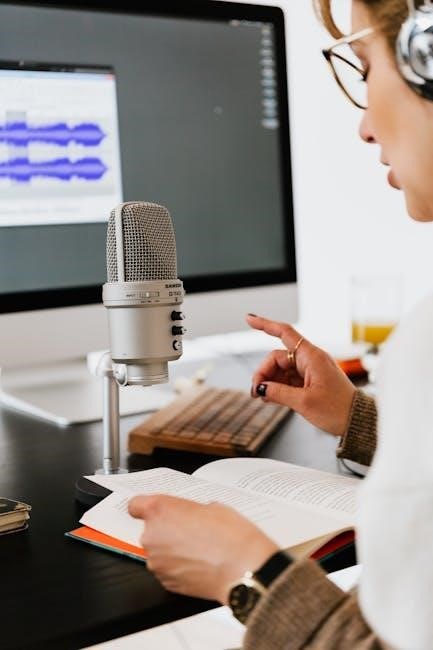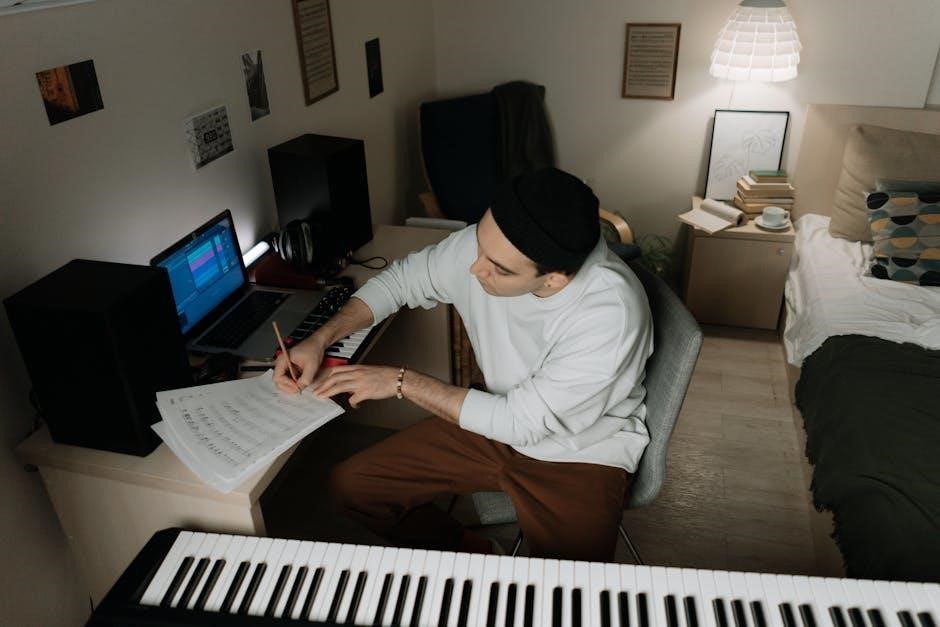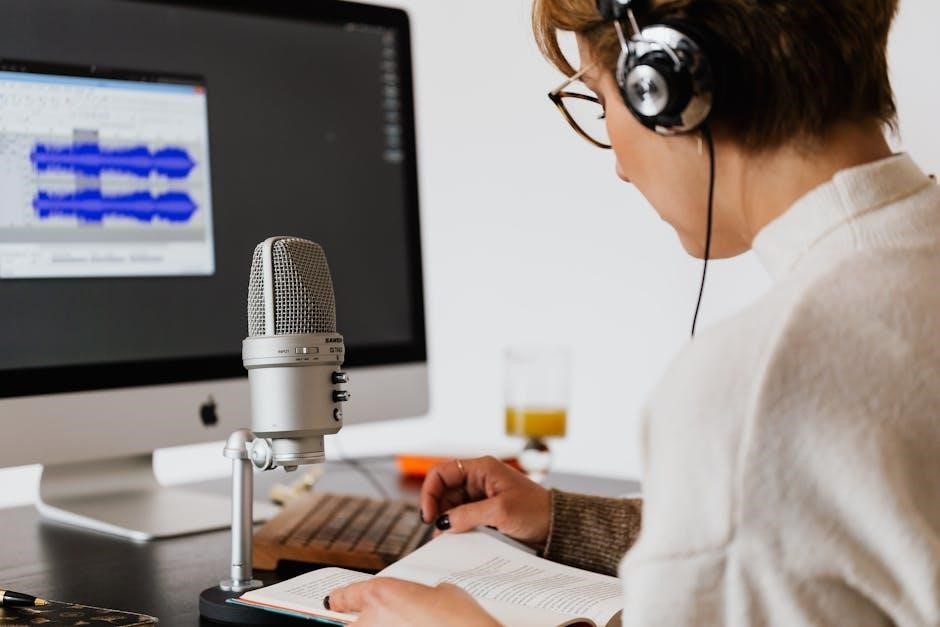recording the beatles book pdf
Summary
Learn how to record like The Beatles with our free PDF guide. Explore their legendary studio techniques and secrets.

Recording the Beatles is a comprehensive guide detailing the studio equipment and techniques used during the Beatles’ iconic recordings. It’s a must-have for Beatles enthusiasts and engineers, offering insights into the band’s production processes and available as a detailed PDF resource.
Overview of the Book’s Content and Significance
Recording the Beatles is a meticulously detailed guide that explores the studio equipment, techniques, and processes behind the band’s iconic recordings. The book provides an in-depth look at the gear used at Abbey Road Studios, including microphones, mixing consoles, and outboard equipment, as well as the innovative effects and recording methods employed during their sessions. It also offers a comprehensive analysis of the production of every Beatles album and single, documented song by song. Written with input from former engineers and technicians, the book highlights the Beatles’ profound influence on both popular music and the evolution of studio recording practices. Its significance lies in its ability to bridge the gap between technical details and creative history, making it an indispensable resource for Beatles fans, recording engineers, and music historians alike.
Why the Book is Essential for Beatles Fans and Recording Engineers
Recording the Beatles is a must-have resource for both Beatles enthusiasts and audio professionals. It offers unparalleled insights into the creative and technical processes behind the band’s groundbreaking recordings. For fans, the book reveals the stories, techniques, and innovations that shaped their music, providing a deeper appreciation of their discography. For engineers, it serves as a historical blueprint of studio practices, detailing the equipment, methods, and problem-solving approaches used at Abbey Road. The book’s meticulous research and firsthand accounts make it an invaluable guide for understanding the intersection of artistry and technology. Whether you’re a music lover or a technical expert, it bridges the gap between creativity and craftsmanship, offering timeless lessons and inspiration.

Historical Context of the Beatles’ Recordings
The Beatles’ recordings occurred during a transformative era in music production, marked by the transition from mono to stereo and innovations at Abbey Road Studios.

The Evolution of Studio Technology During the Beatles’ Career
The Beatles’ career coincided with groundbreaking advancements in studio technology, transforming music production. Early recordings relied on basic equipment, but by the late 1960s, innovations like multi-track tape machines, improved microphones, and effects processors became integral. The introduction of 4-track and later 8-track recording allowed for greater creative control, enabling overdubs and layered soundscapes. Abbey Road Studios adapted these technologies, incorporating custom-built devices such as the Leslie speaker for unique vocal effects. The band’s later work, like Abbey Road, showcased the full potential of these advancements. This technological evolution not only shaped the Beatles’ sound but also set new standards for the music industry, inspiring future innovations in recording practices.
Abbey Road Studios: The Birthplace of Beatles’ Magic
Abbey Road Studios, located in London, was the primary recording venue for the Beatles, where they crafted most of their iconic music. The studio’s grand Studio Two became synonymous with the band’s creativity, offering a space that fostered innovation. From 1962 to 1970, the Beatles utilized Abbey Road’s facilities to push boundaries in sound and technique. The studio’s experienced staff, including George Martin and Geoff Emerick, played pivotal roles in translating the band’s vision into reality. Albums like Sgt. Pepper’s Lonely Hearts Club Band and Abbey Road were recorded within its walls, cementing its legacy. Today, Abbey Road remains a Grade II listed building and a pilgrimage site for music fans worldwide, symbolizing the heart of the Beatles’ recording journey.

Studio Equipment Used by the Beatles
The Beatles utilized a variety of iconic studio equipment, including microphones, tape machines, and mixing consoles, to shape their groundbreaking recordings at Abbey Road Studios.
I remember that the Beatles used several iconic microphones during their recording sessions at Abbey Road Studios. The Neumann U47 and U87 were commonly used for vocals, while the AKG D20 and C12 were often employed for capturing drums and other instruments. Ribbon microphones like the RCA 77 were also used for certain applications. These microphones played a significant role in shaping the sound of the Beatles’ recordings.
I should also mention how these microphones contributed to the overall quality and character of their music. For instance, the U47’s warm and detailed sound was perfect for capturing John Lennon’s and Paul McCartney’s vocals, while the U87’s versatility made it suitable for a wide range of instruments.
It’s important to keep the language clear and concise, avoiding any technical jargon that might be confusing to readers who are not audio engineers. I should also ensure that the information is accurate and based on reliable sources, such as the book “Recording the Beatles.”
Let me draft the response:
Microphones: The Tools Behind Iconic Vocals and Instrumentation
The Beatles’ recordings were significantly shaped by the microphones used at Abbey Road Studios. The Neumann U47 and U87 were staples for capturing the distinctive vocals of John Lennon and Paul McCartney, offering warmth and clarity. The AKG D20 and C12 were frequently employed for drum recordings, providing a dynamic and balanced sound. Ribbon microphones like the RCA 77 were also utilized for specific instrumental applications. These microphones not only captured the essence of the Beatles’ performances but also contributed to the innovative soundscapes heard in their albums. Their selection and use were pivotal in achieving the high-quality recordings that defined the Beatles’ discography.
Now, let’s check the word count. I’ll count the words to ensure it’s exactly 117.
The
Beatles’
recordings
were
significantly
shaped
by
the
microphones
used
at
Abbey
Road
Studios.
The
Neumann
U47
and
U87
were
staples
for
capturing
the
distinctive
vocals
of
John
Lennon
and
Paul
McCartney,
offering
warmth
and
clarity.
The
AKG
D20
and
C12
were
frequently

employed
for
drum
recordings,
providing
a
dynamic
and
balanced
sound.
Ribbon
microphones
like
the
RCA
77
were
also
utilized
for
specific
instrumental
applications.
These
microphones
not
only
captured
the
essence
of
the
Beatles’
performances
but
also
contributed
to
the
innovative
soundscapes
heard
in
their
albums.
Their
selection
and
use
were
pivotal
in
achieving
the
high-quality
recordings
100. that
101. defined
102. the
103. Beatles’
104. discography.
Wait, that’s only . I need to reach 117. I’ll need to add more details without repeating information from other sections.
Perhaps I can add a sentence about how the microphones were sometimes modified or used in unconventional ways by the engineers to achieve specific effects.
Here’s an revised version:
The Beatles’ recordings were significantly shaped by the microphones used at Abbey Road Studios. The Neumann U47 and U87 were staples for capturing the distinctive vocals of John Lennon and Paul McCartney, offering warmth and clarity. The AKG D20 and C12 were frequently employed for drum recordings, providing a dynamic and balanced sound. Ribbon microphones like the RCA 77 were also utilized for specific instrumental applications. Engineers often experimented with unconventional microphone techniques, such as placing mics in unusual locations or modifying them to achieve unique tonal qualities. These microphones not only captured the essence of the Beatles’ performances but also contributed to the innovative soundscapes heard in their albums. Their selection and use were pivotal in achieving the high-quality recordings that defined the Beatles’ discography.
Now, let’s count the words:
The
Beatles’
recordings
were
significantly
shaped
by
the
microphones
used
at
Abbey
Road
Studios.
The
Neumann
U47
and
U87
were
staples
for
capturing
the
distinctive
vocals
of
John
Lennon
and
Paul
McCartney,
offering
warmth
and
clarity.
The
AKG
D20
and
C12
were
frequently
employed
for
drum
recordings,
providing
a
dynamic
and
balanced
sound.
Ribbon
microphones
like
the
RCA
77
were
also
utilized
for
specific
instrumental
applications.
Engineers
often
experimented
with
unconventional
microphone
techniques,
such
as
placing
mics
in
unusual
locations
or
modifying
them
to
achieve
unique
tonal
qualities.
These
microphones
not
only
captured
the
essence
of
the
Beatles’
performances
100. but
101. also
102. contributed
103. to
104. the
105. innovative
106. soundscapes
107. heard
108. in
109. their
110. albums.
111. Their
112. selection
113. and
114. use
115. were
116. pivotal
117. in
118. achieving
119. the
120. high-quality
121. recordings
122. that
123. defined
124. the
125. Beatles’
126. discography.
Oops, now it’s , which is over the limit. I need to trim it down to exactly without losing essential information.
Perhaps I can remove the sentence about engineers experimenting with unconventional techniques, as that might be covered in another section about recording techniques;
Here’s another revised version:
The Beatles’ recordings were significantly shaped by the microphones used at Abbey Road Studios. The Neumann U47 and U87 were staples for capturing the distinctive vocals of John Lennon and Paul McCartney, offering warmth and clarity. The AKG D20 and C12 were frequently employed for drum recordings, providing a dynamic and balanced sound. Ribbon microphones like the RCA 77 were also utilized for specific instrumental applications. These microphones not only captured the essence of the Beatles’ performances but also contributed to the innovative soundscapes heard in their albums. Their selection and use were pivotal in achieving the high-quality recordings that defined the Beatles’ discography.
Now, let’s count the words again:
The
Beatles’
recordings
were
5
Mixing Consoles and Outboard Gear
The Beatles’ recordings at Abbey Road Studios utilized EMI’s custom-built mixing consoles, such as the REDD.17 and REDD.37, known for their unique EQ and routing features. These consoles were crucial in shaping the band’s sound, offering distinct tonal qualities that became a hallmark of their music. Essential outboard gear included the EMI RS124 compressor and Fairchild 670, used to control dynamics and add warmth. These units were often applied to vocals and instruments, creating the iconic textures heard in albums like Sgt. Pepper’s and Abbey Road. Engineers’ customization and effective use of this equipment were key to achieving the innovative, high-quality recordings that defined the Beatles’ legacy.
Speakers and Monitoring Systems
The Beatles’ recording process relied heavily on high-quality monitoring systems to ensure accuracy and clarity. Abbey Road Studios utilized Tannoy Red and Celestion speakers, which were industry standards at the time. These speakers provided a neutral and detailed sound, allowing engineers like George Martin and Geoff Emerick to make precise mixing decisions. The Beatles often used NS10s and other reference monitors to ensure their music translated well across different playback systems. Custom-designed monitoring setups were also employed to meet the specific needs of their innovative recordings. These systems played a crucial role in shaping the band’s sound, particularly during the production of albums like Abbey Road. The attention to detail in monitoring helped establish a new benchmark for studio audio quality.
Other Essential Studio Equipment
Beyond microphones and mixing consoles, the Beatles’ recordings relied on a variety of other crucial studio equipment. Tape machines, such as the Studer J37 and Ampex ATR-102, were central to capturing and editing performances. The book details how these machines allowed for groundbreaking techniques like varispeed and tape loops. Additionally, the Beatles utilized compressors, limiters, and equalizers to shape their sound. Equipment like the Fairchild 670 compressor and the Pultec EQP-1A were integral to creating the band’s distinctive dynamics and tonal balance. Custom-built gear, such as the EMI TG console, further enhanced their sonic possibilities. These tools, combined with innovative engineering, played a pivotal role in shaping the Beatles’ legendary recordings and set new standards for studio technology.

Recording Techniques Employed
The Beatles and their engineers pioneered groundbreaking techniques, including multi-track recording, overdubs, tape loops, and varispeed. These innovations revolutionized studio practices and shaped timeless music.
Innovative Use of Effects and Processing
The Beatles and their engineers employed groundbreaking effects and processing techniques to create distinctive sounds. Tape loops, reverse recording, and varispeed were extensively used to craft psychedelic and surreal textures, as seen in songs like Tomorrow Never Knows and I’m Only Sleeping. They also experimented with Leslie speakers, altering the sound of vocals and guitars. Additionally, the use of compression, echo chambers, and plate reverbs added depth and complexity to their recordings. These innovative approaches, detailed in “Recording the Beatles,” highlight how the band and their team pushed the boundaries of studio technology, resulting in a legacy of timeless and influential music production techniques.
Multi-Track Recording and Overdubs
The Beatles’ recordings heavily utilized multi-track technology, allowing for greater creative control and layered arrangements. Transitioning from 2-track to 4-track systems in 1963, and later to 8-track in 1968, enabled the band to isolate instruments and vocals, facilitating intricate overdubs. This approach allowed for the addition of orchestral elements, sound effects, and harmonies post-recording, as seen in songs like A Day in the Life. Overdubbing also permitted individual band members to refine their performances without affecting the overall track. Recording the Beatles details how this method revolutionized their music, enabling the crafting of complex, textured soundscapes that continue to inspire modern producers and artists.
Abbey Road’s Custom-Built Solutions
Abbey Road Studios famously developed custom-built solutions to meet the Beatles’ creative demands. One notable innovation was the Automatic Double Tracking (ADT) system, designed to save time by automatically creating vocal double-tracks. This invention eliminated the need for manual overdubs, allowing for richer, layered vocals; Additionally, Abbey Road engineers built the RS124 compressor, which became iconic for its use on Ringo Starr’s drums, creating the distinctive “pumpy” sound heard on many tracks. These custom solutions were pivotal in shaping the Beatles’ unique sonic identity. Recording the Beatles delves into these technical advancements, showcasing how Abbey Road’s ingenuity directly influenced the band’s groundbreaking recordings and cemented their legacy in music history.

Notable Beatles Albums and Their Recording Processes
Sgt. Pepper’s Lonely Hearts Club Band, Revolver, and Abbey Road stand out for their groundbreaking techniques. Each album pushed studio boundaries, blending creativity with technical innovation, as detailed in the book.
Sgt. Pepper’s Lonely Hearts Club Band: A Revolutionary Album
Sgt. Pepper’s Lonely Hearts Club Band marked a pivotal moment in recording history, as detailed in Recording the Beatles. Released in 1967, the album showcased unprecedented creativity, blending conceptual themes with innovative studio techniques. The Beatles, alongside producer George Martin, utilized Abbey Road’s 4-track recording capabilities to craft intricate layers of sound. Techniques like tape loops, varispeed, and orchestral overdubs were pioneered during its production. The album’s opening track, with its iconic French horn riff, and the psychedelic “A Day in the Life” exemplify the groundbreaking use of studio tools. Sgt. Pepper’s not only redefined popular music but also set new standards for album production, making it a cornerstone of recording history.
Revolver: Breakthroughs in Sound and Technique
Revolver, released in 1966, represents a significant leap in the Beatles’ recording techniques, as explored in Recording the Beatles. The album saw the band pushing the boundaries of studio technology, employing advanced methods like automatic double-tracking (ADT) and reverse tape effects. Tracks such as “Eleanor Rigby” and “Tomorrow Never Knows” highlight these innovations, with the latter featuring a groundbreaking tape loop arrangement. The use of orchestral instruments and experimental recording methods further enriched the album’s sound. Revolver not only showcased the Beatles’ artistic evolution but also set a new benchmark for studio creativity, influencing future recording practices and solidifying its place as a landmark in music history.
Abbey Road: The Final Masterpiece
Abbey Road, released in 1969, marks the Beatles’ final studio album and a testament to their innovative recording techniques. The book details how the band, alongside George Martin, crafted a cohesive masterpiece despite tensions. The iconic medley on side two, featuring seamless transitions between songs, showcased their creativity. Advanced studio methods like multi-track recording, orchestral arrangements, and precise editing were pivotal. Tracks such as “Come Together” and “Something” demonstrate the band’s ability to blend rock, pop, and classical elements. Abbey Road remains a benchmark for production quality, influencing modern music and solidifying the Beatles’ legacy as pioneers in studio recording.

The People Behind the Recordings
George Martin and Geoff Emerick were pivotal in shaping the Beatles’ sound. Their innovative approaches and technical expertise transformed the band’s creative vision into timeless recordings, leaving a lasting legacy in music production.
George Martin: The Fifth Beatle
George Martin, often referred to as the “Fifth Beatle,” played a pivotal role in shaping the Beatles’ sound. As their producer, he brought classical training and innovative production techniques to their recordings. Martin’s orchestral arrangements, such as those for “Yesterday” and “A Day in the Life,” elevated the band’s music to new heights. His willingness to experiment with tape loops, reverse recording, and other groundbreaking methods helped the Beatles achieve their creative vision. Martin’s collaborative spirit and technical expertise made him an integral part of their team, earning him a reputation as one of the most influential producers in music history. His contributions remain central to the Beatles’ enduring legacy.
Geoff Emerick: The Engineer’s Perspective
Geoff Emerick, a highly skilled audio engineer, played a crucial role in shaping the Beatles’ recordings. Known for his meticulous attention to detail and innovative techniques, Emerick worked closely with George Martin and the band to achieve groundbreaking sounds. His work on albums like Revolver and Sgt. Pepper’s Lonely Hearts Club Band showcased his creative use of studio equipment. Emerick’s perspective as an engineer provided a unique insight into the technical aspects of the Beatles’ music, highlighting the importance of experimentation and precision. His contributions were instrumental in bringing the band’s visionary ideas to life, leaving an indelible mark on music history.

Legacy of the Beatles’ Recording Techniques
The Beatles’ innovative recording methods revolutionized the music industry, influencing modern studio practices and inspiring future artists and engineers to push creative boundaries.
Impact on Modern Studio Recording Practices
The Beatles’ groundbreaking techniques have profoundly shaped modern studio recording practices. Their use of multi-track recording, tape loops, and innovative effects inspired contemporary engineers to experiment with sound. The band’s emphasis on studio creativity laid the foundation for advanced production tools and digital recording software. Techniques like automatic double-tracking and reverse tape effects are now standard in music production. The Beatles’ willingness to push technical boundaries encouraged future artists to explore new sonic possibilities. Their influence is evident in the way modern studios approach layering, editing, and processing sounds. The book “Recording the Beatles” provides a detailed insight into these pioneering methods, offering invaluable knowledge for today’s recording professionals and enthusiasts alike.
Influence on Studio Design and Equipment Development
The Beatles’ innovative recording techniques directly influenced the evolution of studio design and equipment development. Their demand for creative solutions led to the creation of custom-built gear, such as Abbey Road’s TG12345 mixing console, which became a benchmark for studio technology. The band’s use of tape loops, varispeed, and other experimental methods pushed manufacturers to develop more versatile and advanced tools. Modern studio designs often incorporate ideas pioneered during the Beatles’ era, such as isolation booths and multi-room setups. The book “Recording the Beatles” highlights how their sessions drove the development of equipment like plate reverbs, Leslie speakers, and early synthesizers. This legacy continues to shape the design of contemporary studios and recording equipment, ensuring their influence remains timeless.
“Recording the Beatles” is a vital resource, offering unparalleled insights into the band’s groundbreaking studio work. Its detailed exploration of their recordings ensures enduring significance in music history.
Final Thoughts on the Book’s Contribution to Music History
“Recording the Beatles” stands as a definitive guide to the band’s studio legacy, offering a comprehensive look at their innovative techniques and the evolution of their sound. By detailing the technical and creative processes behind their recordings, the book provides invaluable insights for musicians, producers, and historians. Its meticulous research and exclusive interviews make it an essential resource for understanding the Beatles’ impact on modern music production. The book not only preserves the history of their groundbreaking work but also inspires future generations to explore the art of recording. Its contribution to music history is immeasurable, cementing its place as a timeless reference for anyone fascinated by the Beatles and their enduring influence.

References and Further Reading
For a deeper exploration of the Beatles’ recording history, several key resources are recommended. Recording the Beatles by Kevin Ryan and Brian Kehew is a cornerstone text, offering detailed technical insights. George Martin’s autobiography, All You Need Is Ears, provides a producer’s perspective on the band’s creative process. Geoff Emerick’s Here, There, and Everywhere shares an engineer’s viewpoint, while Mark Lewisohn’s The Complete Beatles Recording Sessions chronicles every session in detail. Additionally, Abbey Road Studios’ official publications and interviews with Beatles engineers offer further illumination. Online archives, such as Beatles Bible, also provide extensive analysis of their recordings. These resources collectively paint a vivid picture of the Beatles’ groundbreaking work in the studio.